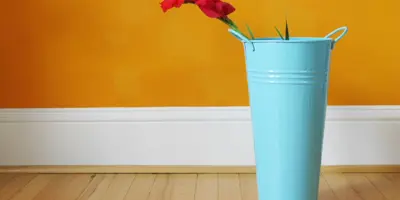1 person found this helpful

There’s nothing quite like getting down and dirty in the garden, stomping in muddy puddles and splashing murky brown water up legs, walls and fences. Gardening isn’t all grubby knees and soggy leaves though – it takes mud, sweat and tears to get things growing outdoors!
Growing from cuttings, however, is a great way to add plants to your outdoor space without spending a fortune or breaking too much of a sweat. Can’t promise you won’t be scooping congealed bits of soil from under your fingernails for the next week though.
But exactly how do you take a cutting from a plant? Follow our step-by-step guide to learn how to cut, grow and care for plant cuttings.
Tip
Wrap the cuttings in damp Plenty kitchen towels when transporting them. The household paper is strong and absorbent enough to help keep cuttings fresh in transit, and breadcrumb trails of mud to a minimum.
Want to know more about Plenty’s compostable kitchen roll sheets? Check out the answers to your frequently asked questions.
How do you take a cutting from a plant?
You can take softwood or hardwood cuttings, and it’s a little more complicated than a simple snip, snip. The technique is slightly different for each, but you’ll need the same basic equipment, which includes:
- Pruning shears
- A bag of potting compost (this will get mucky, so keep a roll of Plenty kitchen paper on hand)
- Pot/container
- Hormone rooting powder
- Clear plastic bag or heated propagator (for softwood cuttings)
Growing cuttings using your own compost
Potting compost is essential for growing plants from cuttings. Good quality potting compost is available from garden centres and larger homeware shops and will do the job, but why not use homemade compost?
Provided your compost is peat-free and free draining, homemade compost is perfect for growing from cuttings! Plus, it’s a fantastic way to recycle organic waste into something useful without it ever leaving the house. If you’re a composting pro already – great! If not, why not read our article explaining the composting process? Want to know what can and can’t be composted? We’ve covered that, too.
Tip
Composting is a wonderful way to turn waste into something useful. That’s why Plenty Original kitchen roll sheets are now certified compostable* for your compostable messes! Now those little messes around the house can benefit the garden.
Want to know more about Plenty’s compostable kitchen roll sheets? Check out the answers to your frequently asked questions.
How to do cuttings from softwood
What? Plants that respond well to softwood cutting propagation (from current season growth) include deciduous shrubs and tender perennials like:
- Choisya
- Fuchsia
- Hebe
- Hydrangea
- Lavender
- Pelargonium
- Penstemon
- Petunia
- Rosemary
- Salvia
- Verbena.
When? New shoots are produced in the warmer months. They’re soft and flexible yet firm enough to be removed and grow roots once potted in damp compost. Spring to early summer is the best time to start growing from cuttings – although your hot and sweaty pits might not agree!
How? You’ll want to pot your softwood cuttings by mid-summer, as they’ll need to have developed strong roots to last through winter. Here’s how:
-

-

-

-

-

-

-

How to plant cuttings from softwood
Once you’ve cut and grown them, you’ll want to know how to plant out your softwood cuttings. A couple of weeks after the roots have developed, you can pot the cuttings individually into 9cm pots to grow on. You’ll want the roots to grow out into a strong rootball. Then you can transfer your new plants into your garden in spring.
How to do cuttings from hardwood
What? Deciduous shrubs, climbers, fruit bushes and trees that are good to grow from hardwood cuttings include:
- Buddleia
- Cornus
- Forsythia
- Honeysuckle
- Jasmine
- Poplar
- Rose
- Fruit bushes like currant, fig and gooseberry.
When? Autumn to mid-winter is the best time for hardwood cutting propagation. Do it in the dormant season, after their leaves fall, but avoiding frosty periods. And you may want to save time for the clean-up: playful householders (four-legged or otherwise) will want to join you in trampling around the garden in the soggy autumn leaves, and then stomping back to the through the house stuck to your feet and paws.
How? Unlike softwood cuttings, you don’t need to keep hardwood cuttings in a moist, warm environment, but you’ll need to wait until the following year to see roots and shoots. Here’s how to take hardwood cuttings:
- Cut a healthy, well-ripened shoot the thickness of a pencil from below a bud/node/leaf joint. You’ll want to end up with a cutting around 20cm long, so cut it longer to begin with.
- Remove the soft growth at the tip above a bud, cutting at an angle. Cut it at the bottom horizontally below another bud or node.
- Dip the bottom in hormone rooting powder.
- Put the cutting in compost in a pot so that two thirds of the cutting is under the surface (great options are loam-based cuttings compost, or potting grit mixed with compost). Make sure at least one node is above the surface.
- If planting multiple cuttings, keep them 10-15cm apart.
- Water the cuttings well and you should see shoots the following spring.
- Leave them in a sheltered position for at least a year before moving.
- If the winter is very cold, you might need to use a cloche/cold frame.
With your newfound knowledge on how to plant cuttings, your garden will be the perfect home for all sorts of wildlife, so watch where you step – or your shoes turn might turn into poo-es! And why stop there? When you’ve mastered the garden, you can turn your green fingers to growing an indoor jungle, too!
*Plenty kitchen towels are certified as home and industrially compostable according to NF T 50-800 and EN14995.
Related articles
Impressive-yet-easy paper crafts for kids that won’t make too much of a mess
Looking for the perfect rainy-day activity for youngsters? Here’s some fun, creative paper craft for kids and their parents to enjoy. Click to read more.

2 easy-but-thoughtful Father's Day craft ideas
Make phone speakers and photo holders from kitchen roll tubes with two simple Father's Day crafts tutorials. Click here for these Father’s Day crafts.

How to make recycling fun: recycling games and upcycling ideas
With these fun ways to recycle everyone can get involved. Discover recycling games for kids and adults alike, to help make collecting and sorting a breeze.

5 top tips for houseplant care
Not sure how often you should water plants or where to put them? Click here for houseplant care tips to help you grow your indoor jungle.

How to keep cut flowers fresh and free of gunky water
That beautiful bloom will last longer when you know how to keep cut flowers fresh. Discover flower care top tips, including how to keep roses alive, here.

How to press flowers at home
Dried flowers look beautiful on greetings cards or artwork. Learn how to press flowers for framing by using our guide to the best way to press flowers.


